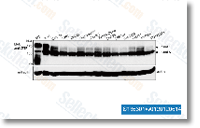The 2nd and third polygenic designs are an RV in the genetic milieu of CVs that leads to ASD once the load of CVs is ample to exceed an arbitrary threshold in addition to a combination of RVs and CVs of numerous impact sizes that exceed a threshold of tolerance. Shared lines of help for the two models are that ASD danger factors, this kind of as 15q11-15q13 and 16p11. 2, which can be unusual inherited disruptions are present in both the unaffected mother or father as well as the impacted offspring, suggesting that added genetic modifiers are essential to confer disorder danger, de novo CNVs are discovered in each scenarios and unaffected controls, again suggesting that extra genetic modifiers are essential for ailment state or that a few of these variants tend not to contribute to sickness state, neuronal networks identified by bioinformatic analysis of transcriptome information are enriched for ASD- related widespread and RVs, and ASD-related part phenotypes are current in family members owing to sub-threshold loading of popular and RVs.
Additional assistance to the polygenic designs comes from the observation that even unusual, de novo nonsense and splice- site mutations selleck increase the odds of ASD by an regular of only 6 fold. This in all probability represents a big array of genotype possibility, but suggests that several uncommon deleterious mutations will not be alone ample to bring about ASD. A fourth form with the polygenic model entails two hits, wherein one particular RV is tolerated but two hits prospects to a disease state, much like cancer. Some examples of this model are presented, and also the model is steady with inherited RVs being current inside the transmitting parent, de novo CNVs being observed in unaffected controls, and relatives manifesting sub-threshold ASD traits.
Nevertheless, a two hit model is almost certainly not the predominant cause based mostly on latest exome information and, even in cancer, wherever this model originated, a even more steady model of genetic contribution is now supported. Taken with each other, there exists the greatest assistance to get a extra constant, and tremendously heterogeneous, polygenic model through which ASD outcomes from a mixture of PHA680632 RVs and CVs that create to exceed a clinical threshold in many distinctive combinations from the population. Emerging biological themes ASD genes fall into numerous likely practical classes, this heterogeneity raises the question of how this kind of varied mechanisms result in ASD.
To solution this question,  it’s vital to recognize the points of probable convergence amongst autism candidate genes in developmental and anatomical terms. Towards this end, expression patterns of ASD genes are annotated implementing whole-genome transcriptome profiling in blood and brain from ASD and management participants. At the similar time, huge efforts are actually made to construct proteomic interactomes of autism candidate genes so as to understand how these molecules functionally intersect.
it’s vital to recognize the points of probable convergence amongst autism candidate genes in developmental and anatomical terms. Towards this end, expression patterns of ASD genes are annotated implementing whole-genome transcriptome profiling in blood and brain from ASD and management participants. At the similar time, huge efforts are actually made to construct proteomic interactomes of autism candidate genes so as to understand how these molecules functionally intersect.
Dehydrogenase Signal
LDH exists in four distinct enzyme classes.
